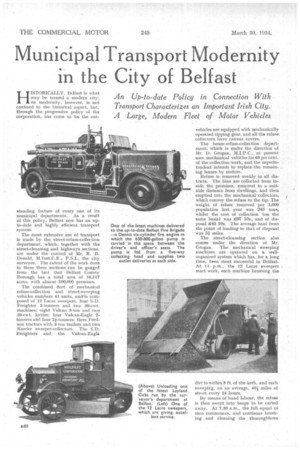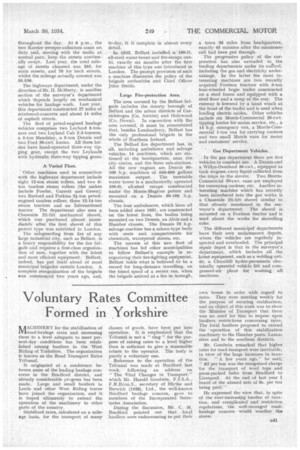Municipal Transport Modernity in the City of Belfast
Page 46

Page 47

If you've noticed an error in this article please click here to report it so we can fix it.
An Up-to-date Policy in Connection With Transport Characterizes an Important Irish City. A Large, Modern Fleet of Motor Vehicles
HISTORICALLY, Belfast is what may be termed a modern city; its modernity, however, is not confined to the historical aspect, but, through the progressive policy of the corporation, has come to be the out
standing feature of every one of its municipal departments. As a result of this policy. Belfast now has an upto-date and highly efficient transport system.
The most extensive use of transport is made by the street-refuse-collection department, which, together with the
• street-cleansing and highways sections, are under the control of Mr. R. B. Donald, M.Inst.C.E., F.S.I., the city surveyor. The extent of the work done in these three sections can be gauged from the fact that Belfast County Borough has a total area of 16,517 acres, with almost 100,000 premises.
The combined fleet of mechanical refuse-collection and street-sweeping vehicles numbers 41 units, and is composed of 12 Lacre sweepers, four S.D. Freighter 2-thrillers and two 30-cwt, machines; eight Vulcan 3-ton and two 30-cwt. lorries; four Vulcan-Eagle 2tonners and four 2+-tonners; three Fordson tractors with 3-ton trailers and two Karrier sweeper-collectors. The S.D. Freighters and the Vulcan-Eagle vehicles are equipped with racchanically operated tipping gear, and all the refuse collectors have canvas covers.
The house-refuse-collection department, which is under the direction of Mr, D. Grogan, at present uses mechanical vehicles for 60 per cent. of the collection work, and the superintendent intends to replace the remain• ing horses by motors.
Refuse is removed weekly in all districts. The bins are collected from inside the premises, removed to a suitable distance from dwellings, turd. then emptied into the mechanical collectors, which convey the refuse to the tip. The weight of refuse removed per 1,000 population last year was 243 tons, whilst the cost of collection (on the same basis) was £97 10s., and of disposal £4.3 10s. The average haul from the point of loading to that of disposal was 3i miles.
the street-cleansing section also comes under the direction of Mr. Grogan. The mechanical sweeping machines are operated on a wellorganized system which has, for a long time, been most successful in Belfast. At 11 p.m., the 12 Lacre sweepers start work, each machine brushing the dirt to within 3 ft. of the kerb, and each sweeping, on an average, 40-i miles of street every 24 hours.
By means of hand labour, the refuse is then swept into heaps to be carted away. At 7.30 a.m., the full squad of men commences, and continues brushing and cleaning the thoroughfares
throughout the day. At 8 p.m., the two Karrier sweeper-collectors come on duty and, moving with the traffic at normal, pace, keep the streets continually swept. Last year, the total mileage of streets cleansed was 255, for main streets, and 70 for back streets, whilst the mileage actually covered was 5.5,536.
The highways department, under the direction of Mr. H. McMurty, is another section of the surveyor's department which -depends largely on mechanical vehicles for haulage work. Last year, this department constructed 27 miles of reinforced-concrete and about 14 miles of asphalt streets.
The fleet of petrol-engined haulage vehicles comprises two Leyland 5-tonners and two Leyland Cub 2-3-tonners, a 5-ton Mantislay, a 5-ton Dennis and two Ford 30-cwt. lorries. All these lorries have hand-operated three-way tipping gear, except the two Leylands with hydraulic three-way tipping gears.
A Varied Fleet. • Other machines used in connection with the highways department include eight I2-ton steam rollers, and two 6ton tandem steam rollers (the makes include Fourier, Garrett and Green); two Barford and Perkins 2k-ton petrolengineil tandem rollers; three 12-14-ton steam tractors and an • International tractor. The department also uses a Chaseside Hi-lift mechanical shovel, which was purchased almost immediately after the first shovel of this patent type was exhibited in London.
The safeguarding from fire of any large industrial city, such as Belfast, is a heavy responsibility for the fire brigade and requires a first-class organization of men, together with the latest and most efficient equipment. Belfast, indeed, has put itself ahead of most municipal brigades outside London. A complete reorganization of the brigade was commenced two years ago, and, to-day, it is complete in almost every detail.
In 1932, Belfast installed a 100-ft. all-steel water-tower and fire-escape outfit, exactly six months after the first machine of this type was introduced in London. The prompt provision of such a machine illustrates the policy of the brigade authorities and Chief Officer John Smith.
Large Fire-protection Area.
The area covered by the Belfast brigade includes the county borough of Belfast and the urban districts of Carrickfergus (Co. Antrim) and Holywood (Co. Down). In connection with the area covered, it must be remembered that, besides Londonderry, Belfast has the only professional brigade in the whole of Northern Ireland.
The Belfast fire department has, in all, including ambulance and salvage vehicles, 14 machines, which are stationed at the headquarters, near the city centre, and the three sub-stations. All the new engines are Dennis 91)100 h.p. machines of 650-800 gallons maximum output. The turntable water tower is a mechanically operated 100-ft. all-steel escape constructed under the Morris-Magirus patent and mounted on a Dennis 90-100 lap. chassis, The four ambulances, which have all been added since 1931, are constructed on the latest lines, the bodies being mounted on two Dennis, an Alvis and a Humbea chassis. The Dennis 70 h.p. salvage machine has a saloon-type body with seats and compartments for chemicals, waterproof sheets, etc. The success of this new fleet of machines has led other municipalities to follow Belfast's example in reorganizing their fire-fighting equipment. Belfast holds what is believed-to he a record for long-distance travelling, on the timed speed of a recent run, when the brigade arrived at a fire in Armagh,
a town 36 miles from headquarters, exactly 45 minutes after thesummonscall had been put through.
The progressive policy of the corporation has also extended to the trading departments under its cOltrol, including the gas and electricity undertakings, In the latter the most interesting machines are two recently acquired Fordson tractors with 3-ton four-wheeled bogie trailer constructed on a steel frame and equipped with a steel floor and a ramp at the rear. The runway is lowered by a hand winch at the front of the trailer and is used when loading electric cables. Other vehicles include six Morris-Commercial 30-cwt. tipping lorries for mains service, etc.., a 14 h.p. emergency van, a Morris-Commercial 1-ton van for carrying cookers and two small Morris vans for meter and customers' service.
Gas Department Vehicles.
In the gas departmeat there are five a-ehicles"in constant use: A Dennis and a Willys-Overland 30-cwt., equipped as tank wagons, carry liquid collected from the traps in the streets: Two MorrisCommercial 30-cwt. vans are employed for conveying cookers, etc. Another interesting machine which has recently been introduced into the gas works is
Chaseside Hi-lift shovel similar to that already mentioned in the surveyor's department. The shovel is mounted on a Fordson tractor and is used about the works for shovelling coke.
The different municipal departments have their own maintenance depots, where the vehicles are regularly inspected and overhauled. The principal repair depot is that in the surveyor's department, which includes all the latest equipment, such as a welding outfit, a Churchill hydro-pneurnatie electrically operated vehicle lift and compressed-air plant foa washing all machines.












































































